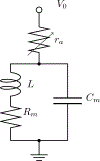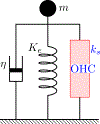Of mice and chickens: Revisiting the RC time constant problem
- PMID: 34965897
- PMCID: PMC12220766
- DOI: 10.1016/j.heares.2021.108422
Of mice and chickens: Revisiting the RC time constant problem
Abstract
Avian hair cells depend on electrical resonance for frequency selectivity. The upper bound of the frequency range is limited by the RC time constant of hair cells because the sharpness of tuning requires that the resonance frequency must be lower than the RC roll-off frequency. In contrast, tuned mechanical vibration of the inner ear is the basis of frequency selectivity of the mammalian ear. This mechanical vibration is supported by outer hair cells (OHC) with their electromotility (or piezoelectricity), which is driven by the receptor potential. Thus, it is also subjected to the RC time constant problem. Association of OHCs with a system with mechanical resonance leads to piezoelectric resonance. This resonance can nullify the membrane capacitance and solves the RC time constant problem for OHCs. Therefore, avian and mammalian ears solve the same problem in the opposite way. This article is part of the Special Issue Outer hair cell Edited by Joseph Santos-Sacchi and Kumar Navaratnam.
Keywords: Auditory frequencies; Electrical resonance; Membrane capacitance; Piezoelectric resonance.
Copyright © 2021. Published by Elsevier B.V.
Figures








Similar articles
-
A rapid and systematic review of the clinical effectiveness and cost-effectiveness of paclitaxel, docetaxel, gemcitabine and vinorelbine in non-small-cell lung cancer.Health Technol Assess. 2001;5(32):1-195. doi: 10.3310/hta5320. Health Technol Assess. 2001. PMID: 12065068
-
LRRC8A Regulates Outer Hair Cell Volume and Electromotility and is Required for Hearing.Adv Sci (Weinh). 2025 Jul 11:e10477. doi: 10.1002/advs.202410477. Online ahead of print. Adv Sci (Weinh). 2025. PMID: 40642832
-
Ear drops for the removal of ear wax.Cochrane Database Syst Rev. 2018 Jul 25;7(7):CD012171. doi: 10.1002/14651858.CD012171.pub2. Cochrane Database Syst Rev. 2018. PMID: 30043448 Free PMC article.
-
Water precautions for prevention of infection in children with ventilation tubes (grommets).Cochrane Database Syst Rev. 2016 Jan 27;2016(1):CD010375. doi: 10.1002/14651858.CD010375.pub2. Cochrane Database Syst Rev. 2016. PMID: 26816299 Free PMC article.
-
Signs and symptoms to determine if a patient presenting in primary care or hospital outpatient settings has COVID-19.Cochrane Database Syst Rev. 2022 May 20;5(5):CD013665. doi: 10.1002/14651858.CD013665.pub3. Cochrane Database Syst Rev. 2022. PMID: 35593186 Free PMC article.
Cited by
-
The Long Outer-Hair-Cell RC Time Constant: A Feature, Not a Bug, of the Mammalian Cochlea.J Assoc Res Otolaryngol. 2023 Apr;24(2):129-145. doi: 10.1007/s10162-022-00884-w. Epub 2023 Feb 1. J Assoc Res Otolaryngol. 2023. PMID: 36725778 Free PMC article. Review.
References
-
- Ehret G, 1976. Development of absolute auditor thresholds in the house mouse (Mus musculus). J. Am. Audiol. Soc. 1:179–184. - PubMed
-
- Rebillard G, and Rubel EW, 1981. Electrophysiological study of the maturation of auditory responses from the inner ear of the chick. Brain Res. 229:15–23. - PubMed
-
- Brownell W, Bader C, Bertrand D, and Ribaupierre Y, 1985. Evoked mechanical responses of isolated outer hair cells. Science 227:194–196. - PubMed
Publication types
MeSH terms
Grants and funding
LinkOut - more resources
Full Text Sources

